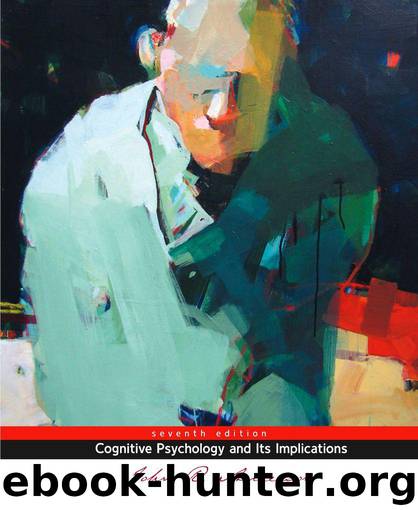Cognitive Psychology and its Implications by John Anderson

Author:John Anderson [Anderson, John]
Language: eng
Format: mobi
Publisher: Worth Publishers
Published: 2009-09-30T14:00:00+00:00
General Characteristics of Skill Acquisition | 247
FIGURE 9.4 Examples of the
spatially transformed texts
used in Kolers’s studies of the
acquisition of reading skills. The
asterisks indicate the starting
point for reading. (From Kolers &
Perkins, 1975.)
reading-speed test, participants practiced on 200 pages of inverted text. Figure 9.5
provides a log-log plot of reading time against amount of practice. In this
figure, practice is measured as number of pages read. The change in speed with
practice is given by the curve labeled “Original training on inverted text.” Kolers
interspersed a few tests on normal text; data for these tests are given by the
curve labeled “Original tests on normal text.” We see the same kind of improve-
ment for inverted text as in Figures 9.2 and 9.3 (i.e., a straight-line function on
a log-log plot). After reading 200 pages, Kolers’s participants were reading at the
rate of 1.6 min per page—almost the same rate as that of participants reading
normal text.
A year later, Kolers had his participants read inverted text again. These data
are given by the curve in Figure 9.5 labeled “Retraining on inverted text.”
Participants now took about 3 min to read the first page of the inverted text.
Compared with their performance of 16 min on their first page a year earlier,
participants displayed an enormous savings, but it was now taking them almost
twice as long to read the text as it did after their 200 pages of training a year
earlier. They had clearly forgotten something. As the Figure 9.5 illustrates,
participants’ improvement on the retraining trials showed a log-log relation
between practice and performance, as had their original training. The same
level of performance that participants had initially reached after 200 pages of
248 | Expertise
16
Original training on inverted text
Retraining on inverted text
Original tests on normal text
Retraining tests on normal text
8
logarithmic scale)
4
2
Reading time (min,
1
0
2
4
8
16
32
64
128
256
Page number (logarithmic scale)
FIGURE 9.5 The results for readers in Kolers’s reading-skills experiment on two tests more
than a year apart. Participants were trained with 200 pages of inverted text in which pages of
normal text were occasionally interspersed. A year later, they were retrained with 100 pages
of inverted text, again with normal text occasionally interspersed. The results show the effect
of practice on the acquisition of the skill. Both reading time and number of pages practiced
are plotted on a logarithmic scale. (From Kolers, 1976. Copyright by the American Psychological Association.
Reprinted by permission.)
training was now reached after 50 pages. Skills generally show very high levels
of retention. In many cases, such skills can be maintained for years with no
retention loss. Someone coming back to a skill—skiing, for example—after many
years of absence often requires just a short warm-up period before the skill is
reestablished (Schmidt, 1988).
Poldrack and Gabrieli (2001) investigated the brain correlates of the
changes taking place as participants learn to read transformed text such as that
in Figure 9.4. In an fMRI brain-imaging study, they found increased activity in
the basal ganglia and decreased activation in the hippocampus as learning pro-
gressed. Recall from Chapters 6 and 7 that the basal ganglia are associated with
procedural knowledge, whereas the hippocampus is associated with declarative
knowledge. Similar changes in the activation of brain areas have been found by
Poldrack et al.
Download
This site does not store any files on its server. We only index and link to content provided by other sites. Please contact the content providers to delete copyright contents if any and email us, we'll remove relevant links or contents immediately.
| Administration & Medicine Economics | Allied Health Professions |
| Basic Sciences | Dentistry |
| History | Medical Informatics |
| Medicine | Nursing |
| Pharmacology | Psychology |
| Research | Veterinary Medicine |
The Art of Thinking Clearly by Rolf Dobelli(9852)
The 5 Love Languages: The Secret to Love That Lasts by Gary Chapman(9223)
Mindhunter: Inside the FBI's Elite Serial Crime Unit by John E. Douglas & Mark Olshaker(8669)
Becoming Supernatural by Dr. Joe Dispenza(7810)
The Road Less Traveled by M. Scott Peck(7256)
Nudge - Improving Decisions about Health, Wealth, and Happiness by Thaler Sunstein(7215)
Mastermind: How to Think Like Sherlock Holmes by Maria Konnikova(6911)
Enlightenment Now: The Case for Reason, Science, Humanism, and Progress by Steven Pinker(6856)
Win Bigly by Scott Adams(6802)
The Way of Zen by Alan W. Watts(6270)
Factfulness: Ten Reasons We're Wrong About the World – and Why Things Are Better Than You Think by Hans Rosling(4475)
The State of Affairs by Esther Perel(4463)
Gerald's Game by Stephen King(4355)
Man's Search for Meaning by Viktor Frankl(4233)
The Confidence Code by Katty Kay(4013)
Thinking in Bets by Annie Duke(3984)
The Worm at the Core by Sheldon Solomon(3308)
Hidden Persuasion: 33 psychological influence techniques in advertising by Marc Andrews & Matthijs van Leeuwen & Rick van Baaren(3282)
Enlightenment Now by Steven Pinker(3265)
